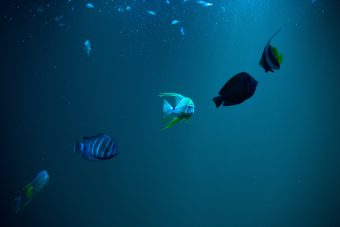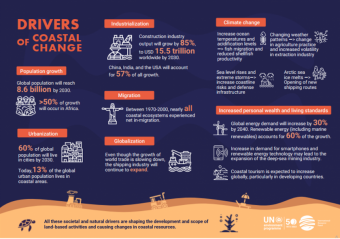
The plants and animals that live along the world’s coasts are coming under increased pressure from pollution tied to harbours, agriculture, and fish and shrimp farming, warns a new report from the International Resource Panel.
The study, Governing Coastal Resources, says there is an urgent need to limit coastal pollution and other byproducts of industry, including the introduction of invasive species. Failing that, some coastal ecosystems, as well as the ocean-based economy they support, could collapse, said the report.
“There is no doubt that the future of the world’s oceans is at risk, and so is the critical role they play in supporting life on Earth and human well being,” said Professor Steve Fletcher, the primary author of the report and a member of the International Resource Panel. The panel is part of the United Nations Environment Programme.
Oceans contain 50 to 80 percent of all life on Earth and many of those plants and animals dwell in coastal areas. Coasts are also vital for human prosperity. They provide resources, including food, energy, and raw materials, while supporting cultural and recreational opportunities. In fact, the blue economy, a phrase that refers to the sustainable use of the ocean’s bounty, accounts for 5 percent of global gross domestic product and relies largely on coastal resources
Threats from agriculture, ports and aquaculture
However, coastal resources are increasingly facing detrimental impacts from human activities on land. For instance, around 80 percent of marine pollution originates onshore. The International Resource Panel’s new report examines numerous land-based sectors and identifies the three that impact coastal resources the most: agriculture, ports and harbours, and aquaculture, which includes fish and shrimp farming.
Agricultural runoff, particularly from chemicals that leach from fertilizer, is a major threat, as are chemical discharges and waste from aquaculture. Nutrients used in both industries, including nitrogen and phosphorus, and persistent toxins can end up in coastal waters, leading to oxygen depletion and creating marine dead zones.
More:
Meanwhile, the construction and operation of ports alter sediment, turbidity and current patterns, which harms coastal ecosystems, such as seagrass meadows. Invasive species can also be introduced through the ballast water of ships. On top of this, port operations and ship engines create noise pollution and generate substantial pollutants.
As the global demand for food and agriculture is projected to rise and the shipping industry to expand, there is an urgent need to manage the impacts of these land-based activities on coastal resources to ensure the sustainability of nature and the blue economy, the report said.
The importance of an integrated land-sea governance approach

Historically the management of the ocean has been fragmented by natural, legal and administrative boundaries, the report said. Land and sea are often governed separately and pertinent sectors are not communicating with each other. Moreover, impacts arising from land-based activities may cross national borders, which creates, even more, governing challenges.
“There are very few, if any, truly effective governance mechanisms that take account of land-ocean interactions,” wrote Izabella Teixeira and Janez Potočnik, Co-Chairs of the International Resources Panel, in the report.
The world needs new governance frameworks that connect land and sea together, and consider the entirety of the impact of land-based stresses, the report urged.
“We’ve got to stop looking at the problem in a fragmented way,” said Fletcher. “Land-based activities in one country may contribute to degradation of coastal resources in another region. “This should now be a global priority.”
An example of integrated land-sea management can be found on the Caribbean coast of Honduras. The landscape has a high-value forest and coastal biodiversity, but also rapidly expanding agricultural production and a growing population. It has experienced extensive degradation of soil, forest, water and biodiversity. The Sustainable Landscapes Programme brings together various land-sea stakeholders to create action plans that meet food security, biodiversity, water and climate change targets. That maximizes the efficiency of coastal and land resources and minimizes the ecological footprint of export products.
The report said the world needs regional regulatory frameworks that would oblige industries to take into account their impact on coastal resources and local communities. It also said monitoring and evaluation frameworks and decision-support tools are important instruments to ensure the effective governance of coastal resources.
In this way, these can better account for, and ideally reduce, the effects of land-based activities on coastal resources and thereby support the transition to a sustainable blue economy, the report said.
Source: UNEP


